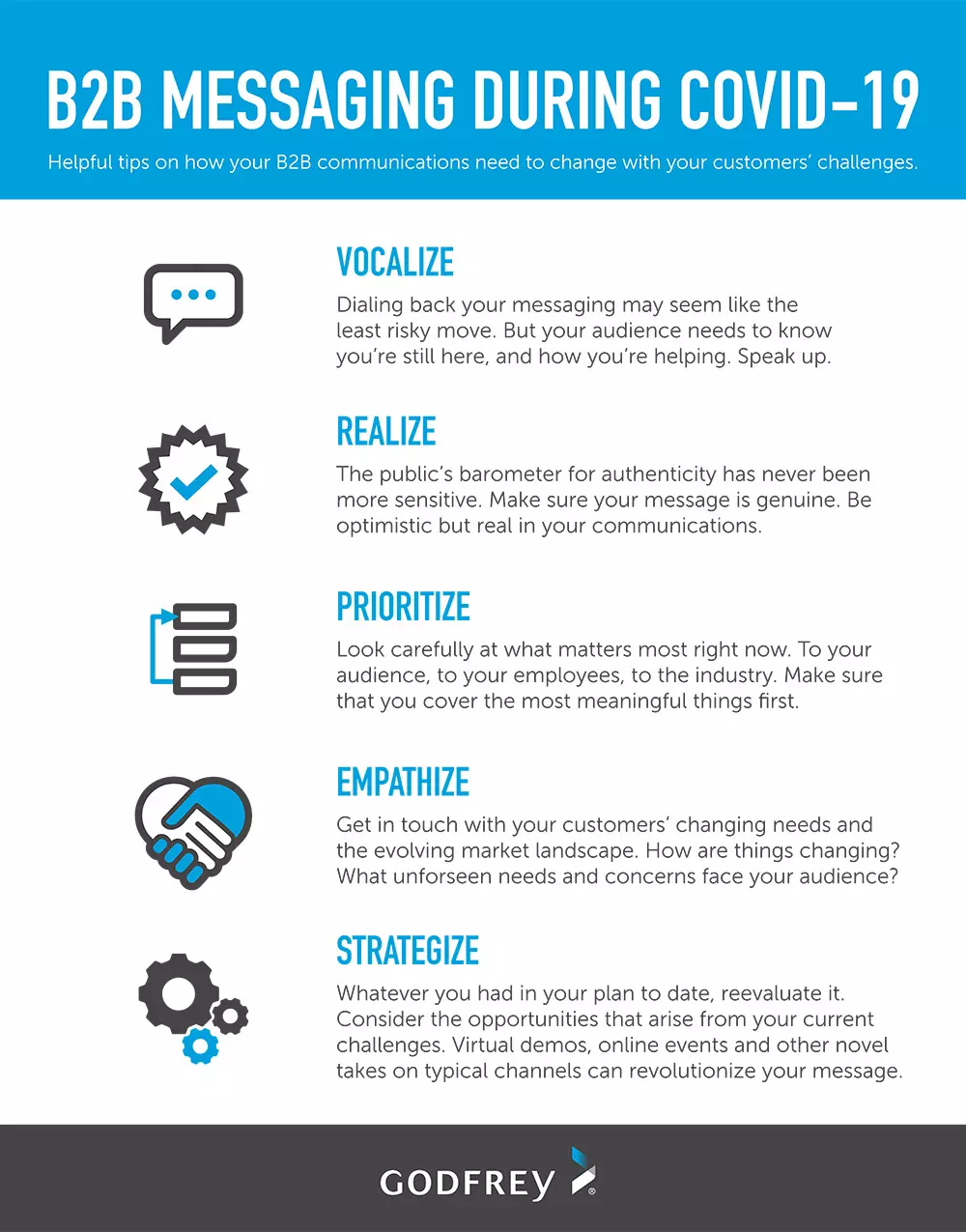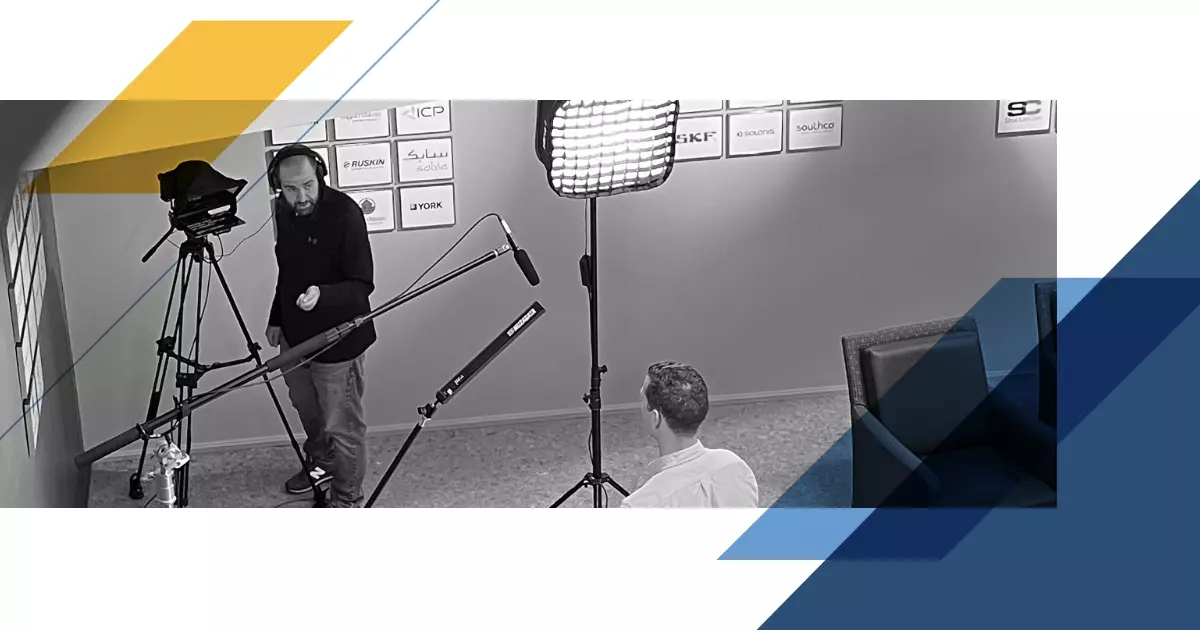Adapt Your B2B Messaging During COVID-19

COVID-19 has affected industries in ways we’ve never seen. Learn how to adjust your messaging to meet your customers’ needs.
“We are in unprecedented times” is possibly the most common statement I’ve encountered recently, at least as an opener to emails. And with good reason — the coronavirus, or COVID-19, has caused disruptions in business and personal spaces across the globe. The bad news is that no one knows for sure how long the crisis will last. The good news is that we’re all in this together.
One thing is undeniable in our industry: Your messaging needs daily care and maintenance right now. From your email campaigns to (virtual) sales calls to social media plans, this pandemic requires action on content and tone ASAP. If you’re not sure exactly where to start with a refresh or an overhaul, the following tips should help.

1. Vocalize.
For many brands, the first impulse is to dial it back. Blame it on cancel culture, or just plain risk avoidance, but saying nothing may feel like the safest bet. But in a time of crisis, customers need to know that the wheels of industry are still moving — that the manufacturers, service providers and supply chain links they rely on are still here and are working both to weather the present storm and to plan for future needs. In fact, surveys have already shown that customers expect brands to be vocal during this time — which means that if you’re silent, you’ll lose them.
So, that’s the easiest thing you can do right now: keep talking. But what you say is as important as showing up.
2. Realize.
Make sure your messaging is genuine. We’ve never seen a time in which so many companies had to address the same subject for such a prolonged period of time. That means that the public’s barometer for authenticity has never been more sensitive. So, be honest and real in your communications. Be optimistic, but ground it in the reality that we are all facing new and difficult challenges. The good news about that is it’s a tremendous opportunity to connect — the virus and resulting fallout is a common enemy we have to fight together. It’s vital to be honest and relatable.
From there, you must ensure that you’re covering the most important bases first.
3. Prioritize.
You’ve got your primary messaging strategy in place and are well into your content calendar for the year. But it’s NOT business as usual at this point. Fundamentally, your customers’ needs have changed drastically. Sure, their concerns for the third and fourth quarters are still important, but they’re not as urgent as the challenges everyone is facing right now. What do they need to hear from you?
For starters, look at how your business is (or isn’t) able to contribute to the efforts to fight the coronavirus. What are you doing? Chemical and pharma are redirecting a lot of efforts to provide disinfectant supplies and various elements needed to work toward a vaccine. Some equipment manufacturers are changing production lines to build ventilators. Still, other industries are simply diverting efforts to build awareness around how we can all do our part.
Next, consider how you’re helping your customers during the disruption. Companies are opening their offerings in new and different ways to help the people who keep them in business. Whether it’s free access to previously paid features, waived shipping charges, or simply being more present and responsive, it’s a way to build connection.
From there, how are you looking out for your employees? Your industry? Your community? Brands that are looking out for the world around them are (rightly) seen as bigger than their products and services. And your customers want that.
And being in touch with what they want — and need — goes a long way.
4. Empathize.
Highlighting your own custom blend of these messages also relies on getting in touch with your customers. Empathy should already be a foundational element of your brand message, but it’s more important now than ever.
How have your audience’s needs changed during this time? The best way to find out is by talking to them. Stay in touch with your customers via any means you can. What are your sales reps hearing from their people? What are the unforeseen challenges they’re facing? What kind of discussion is happening via social media? How easy (or hard) is it to get in touch with customer service right now? How are your products being used in novel ways that you can celebrate to inspire others? The answers to these questions will help shape the tone you take in your communications.
And that tone can be spot-on with a little attention.
5. Strategize.
For now, your marketing strategy might just be off the table. The market has changed, your audience’s immediate needs may be vastly different, and the market is having a VERY different year than anyone predicted. So, look at that strategy — which may well be just fine by next year — and figure out how it needs to change in the near term.
Your team should be able to offer a lot of insight, but you’ll all have to get pretty objective about your strategy if it’s something you’ve lived and breathed for the last six months. And sometimes, you’ll need some help with that. It may be time to bring in some objective help like an agency. Because right now, those of us on the agency side are leveraging our objectivity for clients daily … helping them make sense of the changes to the marketing landscape and how to meet customers’ rapidly evolving needs. From a simple COVID-19 response campaign to full-on virtual product demos and trade events, agencies are working hard to stay in step with industry challenges.
Above all, focus on a grounded but optimistic approach to your market. Now is a great time to get in touch with how your company and industry make a difference in the world. Show your audience that you care, be honest about it, and look for those short-term adaptations that will serve your market well into the future.
With the right attitude and the right follow-through, this crisis (and the innovation and resourcefulness with which you navigate it) could become a turning point that helps your brand become more impactful, more relevant and more vital for your customers and prospects.
Sign Up for our Newsletter - Get agency updates, industry trends and valuable resources delivered directly to you.
Godfrey Team
Godfrey helps complex B2B industries tell their stories in ways that delight their customers.




